Serviços Personalizados
Artigo
Indicadores
Links relacionados
-
 Citado por Google
Citado por Google -
 Similares em Google
Similares em Google
Compartilhar
South African Journal of Animal Science
versão On-line ISSN 2221-4062
versão impressa ISSN 0375-1589
S. Afr. j. anim. sci. vol.43 no.1 Pretoria Jan. 2013
A survey on the effect of transport method on bruises, pH and colour of meat from cattle slaughtered at a South African commercial abattoir
P. Vimiso; V. Muchenje#
Department of Livestock and Pasture Science, University of Fort Hare, Private Bag X1314, Alice, Eastern Cape, South Africa
ABSTRACT
In this study the effect of transport method on bruising, ultimate pH (pHu) and colour of beef (L* = lightness, a* = redness and b* = yellowness) was determined. Cattle transported directly from farms had the highest bruise scores, pHu and the lowest L* values. There were significant correlations between pHu and L*, a* and b* values, (r = -0.45, r = -0.59 and -0.55, respectively), pHu and bruise score (r = 0.34), and L* and bruise score (r = -0.24). There were positive relationships between transport distance and pHu and between distance and bruise score, while the relationship between L* and distance was negative. Percentage of bruised carcasses varied with method of transport: Group 1, 41.1%; Group 2, 63.1% and Group 3, 51.1%. Transport method affected bruising, pHu and colour of beef.
Keywords: Bruise score, ultimate pH, DFD meat, animal welfare, pre-slaughter stress
Introduction
The meat supply chain is an important aspect in the farming and meat industry that includes various critical stages such as transportation, loading and slaughter of the animals (Ali et al, 2006; Ljunberg et al., 2007; Tadich et al, 2009). Furthermore, many farmers have developed intermediate stages in the chain, thus making the process dynamic and often complicated. In South Africa, cattle are marketed through a number of channels, with selling through butcheries, auctions and abattoirs playing a leading role (Musemwa et al., 2007). The use of auction markets, holding farms or feedlots often exposes the animals to stressful conditions and a breach to animal welfare (Ferguson & Warner, 2008), often resulting in bruises (Strappini et al, 2010).
Transportation of animals may vary depending on the source of the animals and in South Africa, cattle that are sold at auction markets can either be transported straight to the slaughterhouse for direct slaughter or can be taken to farms or feedlots where they are held before released for slaughter (Coetzee et al., 2004; Musemwa et al, 2008). The various transportation methods imparts different degrees of bruising, and findings by Weeks et al. (2002) showed higher bruises in cattle sourced directly from the auction markets than in cattle sourced directly from the farm. Contrary to these reports, Ljunberg et al. (2007) reported no significant differences between the bruise scores of animals slaughtered after transport direct from farms and those from livestock markets, although bruise distribution was different.
Bruised cattle are stressed and are expected to produce an abnormally high pH in the muscle because of glycogen depletion and the subsequent lower production of lactic acid in the muscles (Kannan et al, 2002). A high pH favours the development of dark, firm, dry (DFD) beef and a reduction of shelf life of meat (Chambers et al, 2004). Beef with an ultimate pH (pHu) of above 6.0 presents many quality problems such as dark red colour, toughness, increased water holding capacity and poor palatability (Apple et al., 2005; Mounier et al., 2006; Muchenje et al., 2009a).
Most studies tend to focus on stress (Ndlovu et al, 2009; Odore et al, 2011) and meat quality (Muchenje et al., 2008; 2009b) separately, yet the way an animal is handled before slaughter is likely to affect the quality of the meat (Muchenje et al., 2009a). Furthermore, information on animal stress and how it affects meat quality under practical situations, especially in low throughput abattoirs which have low levels of mechanisation, is generally lacking. Such lack of information is more pronounced when considering animals marketed and transported through different methods to the abattoirs in rural communities. Also limited, is the use of bruise ageing to predict the time of occurrence of bruises and the relationship between bruised carcasses and the development of pH, colour and DFD beef. This, despite the fact that information on animal welfare and meat quality is quite critical for veterinarians and the animal/meat industry. The objective of the study was therefore to determine carcass bruising at the abattoir, beef colour and pHu. The study also sought to quantify the relationship between bruising, colour and pHu with animal characteristics, seasonal conditions, marketing channel and mode of transportation.
Materials and Methods
The study was conducted at the Adelaide municipal abattoir (32.8 °S and 26.9 °E) in the rural town of Adelaide (Nxuba Local Municipality), Amatole District Municipality in the Eastern Cape Province of South Africa. The abattoir is classified as low throughput. The day temperature range for the period of study was from 8 °C to a high of 35 °C with a mean temperature of 21.5 °C. The average daily temperatures during transportation were obtained from the Adelaide town weather records.
Data were collected from 315 cattle that were divided into three groups depending on their marketing history and mode of transport to the abattoir. Group 1 was walked to the abattoir from feedlots or holding farms close to the abattoir, Group 2 was transported by road from various farms to auction markets and then directly to the abattoir while Group 3 was transported by road directly from the farms to the abattoir.
Truck identification, the number of animals loaded on the truck, the stocking density in the truck and the transportation distances were recorded for Groups 2 and 3. For Group 1, transportation distance was obtained by herding the cattle on routes where the distances were predetermined.
Data on animal source (farm, feedlot or auction market), breed and sex were recorded on arrival at the abattoir. The cattle were slaughtered directly upon arrival. Slaughtering was done through stunning by captive bolt, suspension by a hind leg and exsanguination. Meat inspection and classification were done by a qualified meat inspector.
Bruise score assessment was done using a method based on the Australian Carcass Bruise Score System (Anderson & Horder, 1979). After dressing, the carcasses were examined and the size and colour of every bruise were recorded. The maximum diameter was estimated as: little (<2 cm), slight (2 - 8 cm), medium (8 - 16 cm) or heavy (>16 cm). Bruise scores were calculated for each load by multiplying the number of bruises in each size class by a weighting factor: slight 1, medium 3 and heavy 5, and adding these values (Anderson & Horder, 1979). These bruise scores were then divided by the number of cattle per load to give a mean bruise score per animal for each load.
Bruise age was estimated using the method of Gracey et al. (1999) as described in Table 1.

Measurement of pH was done in the longissimus dorsi muscle at the level of the 10 rib, approximately 24 hours after slaughter, of carcasses that were refrigerated at 0 - 3 °C. The measurement was carried out using a portable pH meter (CRISON pH25, CRISON Instruments SA, Spain) that was calibrated using pH 4, pH 7 and pH 9 standard solutions (CRISON Instruments, SA, Spain) before each day's measurement. The carcasses were classified as normal when the pH was <6, or as DFD beef at a pH of >6 (Muchenje et al., 2009a).
Colour of the meat (L* = lightness, a* = redness and b* = yellowness) was determined in the longissimus dorsi 24 hours after slaughter, using a colour-guide 45/0 BYK-Gardener GmbH machine, with a 20 mm diameter measurement area and illuminant D65-day light, 10 standard observer. Three readings were taken by rotating the Colour Guide 90 between each measurement, in order to obtain a representative average value of the colour. The guide was calibrated before each day's measurements using the green standard.
The effect of transport method on bruises, pH and colour was analysed using the General Linear Model (PROC GLM; SAS, 2003). The proportion of carcasses with potentially DFD beef and the prevalence of bruises by transport method were determined using the frequency procedure (PROC FREQ; SAS, 2003). Significant differences between least- square group means were analysed using the PDIFF procedure of SAS (2003). A regression analysis was done to determine the relationship of varying distances, stocking density (Groups 2 and 3) and day temperature on bruise score, bruise age, pH24 and colour (PROC REG; SAS, 2003), while correlations were done for the relationship between transport method and other meat quality related data and between pH and colour (PROC CORR; SAS, 2003).
Results and Discussion
Meat quality variables that were affected by transport method are presented in Table 2. A total of 315 cattle passed through the abattoir during the survey period; 158 were in Group 1, 65 in Group 2 and 92 in Group 3. Cattle received on hoof constituted the highest number that passed through the abattoir during the study period.
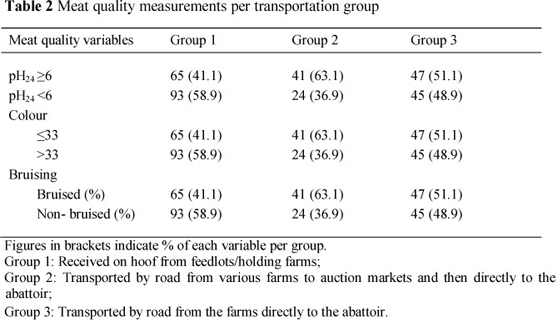
The bruised and non-bruised carcasses in each group are shown in (Table 2). Percentage of bruised carcasses varied with method of transport: Group 1, 41.1%; Group 2, 63.1% and Group 3, 51.1%, but the actual bruise scores reflected a different pattern.
The bruise scores were significantly higher in carcasses in Groups 2 and 3 than in Group 1 (Table 3) and there was no significant difference in bruise scores between Groups 2 and 3 carcasses. This is in accordance with Ljunberg et al. (2007) who found no significant differences in bruise scores between farm and auction marketed cattle. The percentage of bruising for Group 1 cattle reflects their marketing history. These cattle were transported by road from different farms to the markets where the meat traders purchased them and then transported them by road again to holding farms. Since auction markets are held monthly and the purchased cattle are only slaughtered when there is demand, the cattle were kept for various periods of time before they were slaughtered. Although Group 2 cattle had the highest percentage of bruised carcasses, as expected, and in agreement with the findings by Weeks et al. (2002) and Strappini et al. (2010), Group 3 carcasses actually had the highest bruise scores. This can be explained by the possible modifying effect of transportation distance.
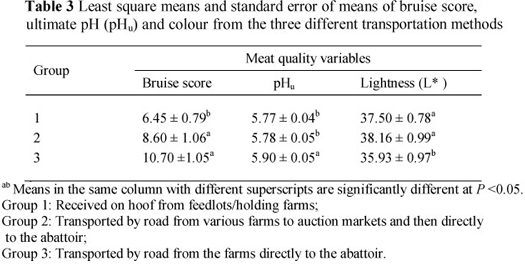
Distance was found to have a significant and positive effect on bruise score (Table 4). In this study cattle from farms were transported over longer distances compared to cattle from the auction markets. The fact that distance had a positive relationship with bruise score might explain the high bruise scores in cattle that came directly from farms. According to Hoffman et al. (1998), distance is positively correlated with amount of bruising.
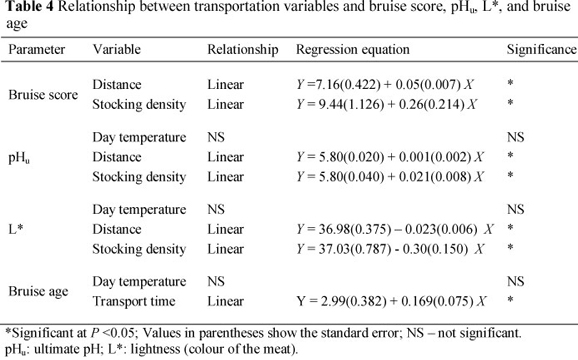
The evaluation of bruise age reflected an interesting pattern. Group 1 carcasses had the oldest bruises, (92.4% was older than 10 hours), and this group also had the greatest number of dark and yellowish bruises, thus reflecting the history of the animals. The age of the majority of bruises in Groups 2 and 3 aged was less than 10 hours (66% and 72%, respectively) (Table 5).
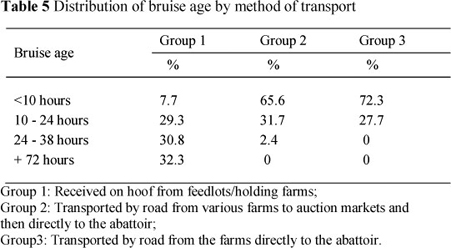
The findings for the three groups are in agreement with that of Gracey et al. (1999). Bruise age is dependent on time between occurrence of the injury and the time of assessment. In this study, bruise age had a significant and positive relationship with duration of transportation (Table 4). Although interpretation of bruise age based only on visual assessment is not precise, bruise age was found to be significantly related with duration of transportation in this study. It must, however, be acknowledged that assessing bruise age using bruise colour changes in not a reliable method. The limitation of this method lies in the difficulty of accurately separating bright red bruises from dark red bruises. This is entirely due to ageing of the bruise as the difference in colour can be affected by the contribution of venous blood or arterial blood at the site. Another limitation of the method is that observation of a watery bruise can be due to oedema rather than ageing of the bruise.
Meat pH24 was greater than or equal to 6.0 for 41.1% of Group 1, 63.1% of Group 2 and 51.1% of Group 3 carcasses (Table 2). Similar results were also found for L* < 33 and in both cases the carcasses were classified as DFD beef. There was also a significant positive correlation between pHu and bruises (Table 6).
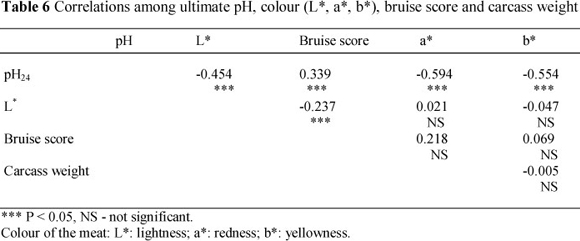
These findings show a relationship between bruising and DFD beef and concur with McNally & Warriss (1996) who reported 48% of bruised carcasses having pHu values greater than 5.8. The presence of bruises is a reflection of transportation problems and when animals are stressed, glycogen reserves are depleted and higher pH can be obtained (Muchenje et al., 2009a; b). The relationship between the pHu and DFD beef is also supported by the colour values obtained in the three groups (Table 2). Beef L* values less than 33 indicate beef that is dark and translates to DFD beef (Muchenje et al., 2008). While the above statements can be true for Groups 2 and 3, Group 1 cattle received a different treatment prior to slaughter. These cattle may have been stressed by the way they were herded to the abattoir. Walking cattle alone without food and water can be stressful, leading to glycogen depletion and high pHu and low L* values. Group 3 carcasses had significantly higher pH24 values and significantly lower L* than both Group 2 and Group 1.
Other factors can have a significant affect on meat quality in terms of colour and pHu. Method of transport affected pHu and L* (Table 5). Although there was a significant positive linear relationship between distance and pHu, the pH values obtained could have been due to other factors than distance, since moderate transportation distances do not have an effect on pHu (Mach et al, 2008; Odore et al, 2011). Factors that could have negatively affected carcass pH and hence colour include poor handling during loading and unloading (slip and fall), lack of water and food at the market and poor handling during transportation. From the regression analysis, a significant positive linear effect of distance, stocking density and transportation duration on pHu was observed, while a significant negative linear effect of distance, stocking density and transportation duration was observed on L* (Table 5). The positive linear relationship between stocking density and amount of bruising explains the increase in bruising that occurred with increasing stocking density. According to Gregory (2008), bruising increases with increase in stocking density because cattle that fall down tend to be trampled by others as they try to occupy the available space. Significant correlations were found between pHu and L* (negative), pHu and bruise score (positive), L* and bruise score (negative).
Other variables studied such as day temperature did not have an effect on meat quality. in accordance to Strappini et al. (2010).
Conclusion
Method of transport had an effect on bruising, beef colour and ultimate pH. Bruising was more prevalent in cattle that passed through the markets. Increased stocking density, distance and transportation duration had negative effects on cattle welfare and the quality of beef. Bruising was associated with increased carcass pH and the development of DFD beef.
Acknowledgements
This study was partially funded by the Govan Mbeki Research and Development Centre (Project 263) and the National Research Foundation (Protect T039). The study was conducted at the Adelaide Abattoir in South Africa. The views expressed in this article are not those of the sponsors and the participating abattoir.
References
Ali, B.H., Al-Qarawi, A.A. & Mousa, H.M., 2006. Stress associated with road transportation in desert sheep and goats, and the effect of pre treatment with xylazine or sodium betaine. Res. Vet. Sci. 80, 343-48. [ Links ]
Anderson, B. & Horder, J.C., 1979. The Australian carcass bruise scoring system. Queensl. Agric. J. 105, 281-287. [ Links ]
Apple, J.K., Kegley, E.B., Galloway, D.L., Wistuba, T.J. & Rakes, L.K., 2005. Duration of restraint and isolation stress as a model to study the dark-cutting condition in cattle. J. Anim. Sci. 83, 1202-1214. [ Links ]
Coetzee, L., Montshwe, B.D. & Jooste, A., 2004. The marketing of livestock on communal lands in the eastern cape province: constraints, challenges and implications for the extension services. S. Afr. J. Agric. Ext. 34, 81-103. [ Links ]
Eldridge, G.A. & Winfield, C.G., 1988. The behaviour and bruising of cattle during transport at different space allowances. Aust. J. Exp. Agric. 28, 695-698. [ Links ]
Ferguson, D.M. & Warner, R.D., 2008. Have we underestimated the impact of pre-slaughter stress on meat quality in ruminants? Meat Sci. 80, 12-19. [ Links ]
Gracey, J.G., Collins, D.S. & Huey, R.J., 1999. Meat Hygiene. 10th ed. London: Balliere Tindall. [ Links ]
Grandin, T., 2000. Livestock Handling and Transport. 2nd ed., CAB International, Wallingford, UK. [ Links ]
Gregory, N.G., 2008. Animal welfare at markets and during transport and slaughter. Meat Sci. 80, 2-11. [ Links ]
Hoffman, D.E., Spire, M.F., Schwenke, J.R. & Unruh, J.A., 1998. Effect of source of cattle and distance transported to a commercial slaughter facility on carcass bruises in mature beef cows. J. Am. Vet. Med. Ass. 212, 668-672. [ Links ]
Jago, J.G., Hargreaves, A.L., Harcourt, R.G. & Matthews, L.R., 1996. Risk factors associated with bruising in red deer at a commercial slaughter plant. Meat Sci. 40, 181-191. [ Links ]
Kannan, G., Chawan, C.B., Kouakou, B. & Gelaye, B., 2002. Influence of packaging method and storage time on shear value and mechanical strength of intramuscular connective tissue of chevon. J. Anim. Sci. 80, 2383-2389. [ Links ]
Ljunberg, D., Gebresenbet, G. & Aradom, S., 2007. Logistics chain of animal transport and abattoir operations. Biosystems Eng. 96, 267-277. [ Links ]
Mach, N., Bach, A., Velarde, A. & Devant, M., 2008. Association between animal, transportation, slaughterhouse practices, and meat pH in beef. Meat Sci. 78, 232-238. [ Links ]
McNally, P.W. & Warriss, P.D., 1996. Recent bruising in cattle at abattoirs. Vet. Rec. 138, 126-128. [ Links ] Mounier, L., Dubroeucq, H., Andanson, S. & Veissier, I., 2006. Variations in meat pH of beef bulls in relation to conditions of transfer to slaughter and previous history of the animals. J. Anim Sci. 84, 1567-1576. [ Links ]
Muchenje, V., Dzama, K., Chimonyo, M., Strydom, P.E. & Raats, J.G., 2008. Meat quality of Nguni, Bonsmara and Aberdeen Angus steers raised on natural pasture in the Eastern Cape, South Africa. Meat Sci. 79, 20-28. [ Links ]
Muchenje, V., Dzama, K., Chimonyo, M., Strydom, P.E., Hugo, A. & Raats, J.G., 2009b. Some biochemical aspects pertaining to beef eating quality and consumer health: a review. Food Chem. 112, 279-289. [ Links ]
Muchenje, V., Dzama, K., Chimonyo, M., Strydom, P.E. & Raats, J.G., 2009a. Relationship between pre-slaughter responsiveness and beef quality in three cattle breeds. Meat Sci. 81, 653-657. [ Links ]
Musemwa, L., Chagwiza, C., Sikuka, W., Fraser, G., Chimonyo, M. & Mzileni, N., 2007. Analysis of cattle marketing channels used by small scale farmers in the Eastern Cape Province, South Africa. Livestock Research Rural Development 19, Article No. 131. [ Links ]
Musemwa, L., Mushunje, A., Chimonyo, M., Fraser, G., Mapiye, C. & Muchenje, V., 2008. Nguni cattle marketing constraints and opportunities in the communal areas of South Africa: Review. Afr. J. Agric. Res. 3, 239-245. [ Links ]
Ndlovu, T., Chimonyo, M., Okoh, A.I., Muchenje, V., Dzama, K., Dube, S. & Raats, J.G., 2009. A comparison of nutritionally-related blood metabolites among Nguni, Bonsmara and Angus steers raised on sweetveld. Vet. J. 179, 273-281. [ Links ]
Odore, R., Badino, P., Re, G., Barbero, R., Cuniberti, B., DAngelo, A., Girardi, C., Fraccaro, E. & Tarantola, M., 2011. Effects of housing and short-term transportation on hormone and lymphocyte receptor concentrations in beef cattle. Res. Vet. Sci. 90, 341-345. [ Links ]
Strappini, A.C., Metz, J.H.M., Gallo, G. & Kemp, B., 2009. Origin and assessment of beef cattle at slaughter. Animal 3, 728-736. [ Links ]
Strappini, A.C., Frankena, K., Metz, J.H.M., Gallo, G. & Kemp, B., 2010. Prevalence and risk factors for bruises in Chilean bovine carcasses. Meat Sci. 86, 859-864. [ Links ]
Tadich, N., Gallo, C., Brito, M. & Broom, D.M., 2009. Effects of weaning and 48 h transport by road and ferry on some blood indicators of welfare in lambs. Livest. Sci. 121, 132-136. [ Links ]
Warriss, P.D., 2000. Meat Science: An Introductory Text, Wallingford, Oxon, UK: CABI Publishing. [ Links ]
Warriss, P.D., Kesten, S.C., Brown, S.N. & Wilkins, L.J., 1984. The time required for recovery from mixing stress in young bulls and the prevention of dark cutting beef. Meat Sci. 10, 53-68. [ Links ]
Weeks, C.A., McNally, P.W. & Warriss, P.D., 2002. Influence of the design of facilities at auction markets and animal handling procedures on bruising in cattle. Vet. Rec. 150, 743-748. [ Links ]
Wythes, J.R. & Shorthose, W.R., 1991. Chronological age and dentition effects on carcass and meat quality of cattle in Northern Australia. Aust. J. Exp. Agric. 31, 145-152. [ Links ]
Wythes, J.R., Kaus, R.K. & Newman, G.A., 1985. Bruising in beef cattle slaughtered at an abattoir in Southern Queensland. Aust. J. Exp. Agric. Anim. Husb. 25, 727-733. [ Links ]
Received 18 May 2012
Accepted 15 January 2013
First published online 24 April 2013
Copyright resides with the authors in terms of the Creative Commons Attribution 2.5 South African Licence. See: http://creativecommons.org/licenses/by/2.5/za Condition of use: The user may copy, distribute, transmit and adapt the work, but must recognise the authors and the South African Journal of Animal Science.
# Corresponding author: vmuchenje@ufh.ac.za














